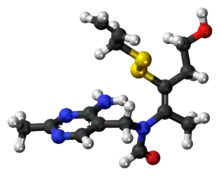Allithiamine
Allithiamine (thiamine allyl disulfide or TAD) is a lipid-soluble form of vitamin B1 which was discovered in garlic (Allium sativum) in the 1950s along with its homolog prosultiamine.[1] They were both investigated for their ability to treat Wernicke–Korsakoff syndrome and beriberi better than thiamine.[2]
 | |
 | |
| Clinical data | |
|---|---|
| ATC code |
|
| Identifiers | |
| |
| CAS Number | |
| PubChem CID | |
| ChemSpider | |
| UNII | |
| Chemical and physical data | |
| Formula | C15H22N4O2S2 |
| Molar mass | 354.49 g·mol−1 |
| 3D model (JSmol) | |
| |
| |
| | |
See also
References
- Fujiwara M, Watanabe H, Matsui K (1954). ""Allithiamine" A Newly Found Derivative of Vitamin B1". The Journal of Biochemistry. 41: 29–39. doi:10.1093/oxfordjournals.jbchem.a126421.
- Rogers EF (April 1962). "Thiamine antagonists". Annals of the New York Academy of Sciences. 98 (2): 412–29. Bibcode:1962NYASA..98..412R. doi:10.1111/j.1749-6632.1962.tb30563.x. PMID 14493332. S2CID 32281714.
This article is issued from Wikipedia. The text is licensed under Creative Commons - Attribution - Sharealike. Additional terms may apply for the media files.